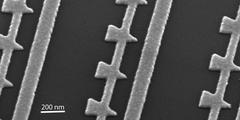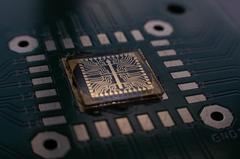URL: https://www.desy.de/news/news_search/index_eng.html
Breadcrumb Navigation
DESY News: Nanoantennas pave the way to compact petahertz oscilloscopes
News
News from the DESY research centre
Nanoantennas pave the way to compact petahertz oscilloscopes
A team of researchers from the Massachusetts Institute of Technology (MIT, Boston, USA), DESY, the University of Hamburg and the University of California at Davis (USA), has succeeded in generating electron pulses with a duration of only a few hundred attoseconds on metallic nanoantennas and used them to measure extremely weak electric fields. An attosecond (as) corresponds to the billionth part of a billionth of a second. Comparable measurements were previously only possible with complex set-ups that generate attosecond UV pulses with complex laser systems. The method now demonstrated is even able to scan fields with a sensitivity a million times better than previously possible, and this without the use of elaborate laser or vacuum setups, but with a simple fibre laser setup and a small integrated chip. “With our new technique, we could even build oscilloscopes that make the oscillations of light visible,” explains DESY researcher Felix Ritzkowsky, one of the lead authors of the study, which the international team has now published in the journal Nature Photonics.

Scanning-electron-microscope image of the out of gold fabricated nanoantennas. The triangles are the actual nanoantennas. They generate a large electric field at their tip, similar to a lightning rod. The large field creates the electron pulse which is captured by the long striplines and subsequentially read out with conventional electronics (picture: M. Turchetti, MIT).
Independent of the observed frequency, the oscilloscope records the electric fields by discrete sampling. It thus measures the shape of the wave by determining the respective height of the wave at much shorter intervals than a wave cycle. In conventional electronics, this is done by quick circuit switching and reading the instantaneous field strength of the signal, similar to stroboscopic photo series.
In modern optics, which deals with light, i.e. electromagnetic waves in the petahertz range (1015 Hz), conventional oscilloscopes cannot be used directly, so a variety of direct and indirect optical methods are used to record the light waves.
In their current investigations, however, the researchers have now been able to demonstrate that the scanning technique of conventional oscilloscopes can also be adapted for attosecond switching of electron pulses in nanoantennas.

The nanoantennas used in the experiment are made on a glas chip and are fully integrated into a printed circuit board (photo: N. Abedzadeh, MIT).
This technique is an important advance in the application of ultrashort light-matter interaction and will allow new phenomena to be studied with higher sensitivity and attosecond resolution in time. “The new petahertz oscilloscope has the potential to fundamentally change measurement technology in the optical field, especially spectroscopy,” says Franz Kärtner, Leading Scientist at DESY in Hamburg, who was influential in shaping this research direction at MIT. “The method enables spectroscopic determination of amplitude and phase of transmission from the microwave range to the UV range with a single instrument that can be shrunk to chip size in the future.” Phillip Keathley, lead researcher on the project at MIT, envisions a wide range of potential applications: “For example, this method will help researchers better understand the absorption mechanisms of light in plants or in photovoltaics, or better identify molecular fingerprints in complex biological systems.”
The experiments in the study, with lead authors Mina Bionta, Felix Ritzkowsky and Marco Turchetti, were conducted at the Research Laboratory of Electronics (RLE) at MIT and funded in part by the MIT-PIER Hamburg Seed Programme. This programme, funded by the Hamburg Ministry of Science, Research, Equality and Districts, supports exchanges between DESY, the University of Hamburg and Boston-based universities such as MIT, Harvard and Boston University, and enabled DESY researcher Felix Ritzkowsky to spend a research period at MIT. The experiments were further supported by the United States Air Force Office of Scientific Research through their Young Investigator Program and Multidisciplinary University Research Initiative; the European Research Counsel; the SENSE.nano seed grant program at MIT.
Reference
M. Bionta, F. Ritzkowsky, M. Turchetti, et al. On-chip sampling of optical fields with attosecond resolution. Nature Photonics (2021) DOI: 10.1038/s41566-021-00792-0



